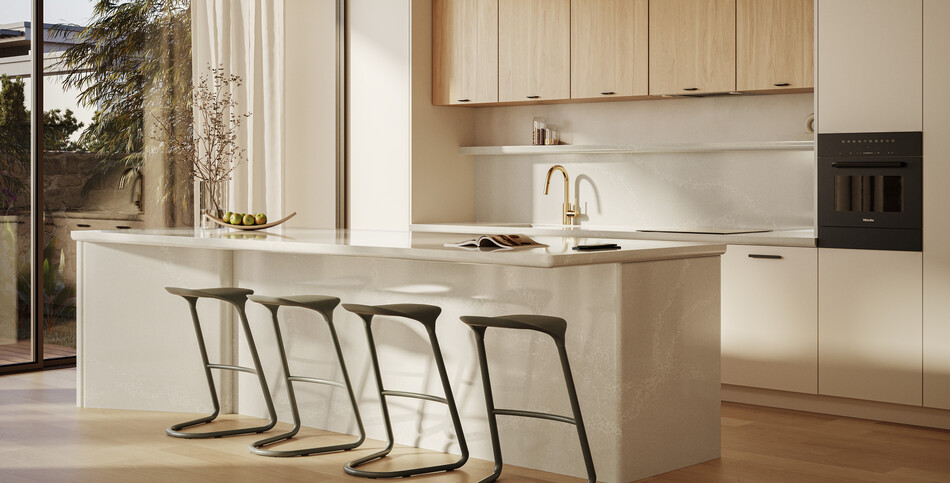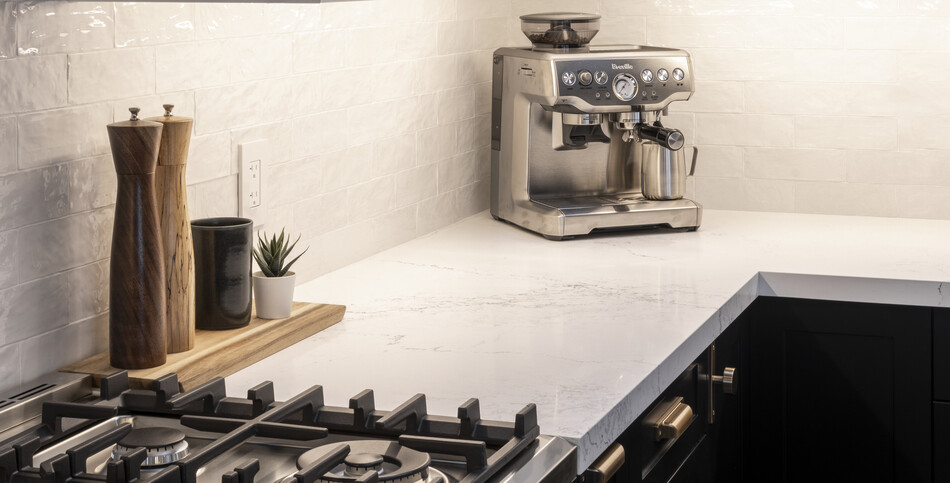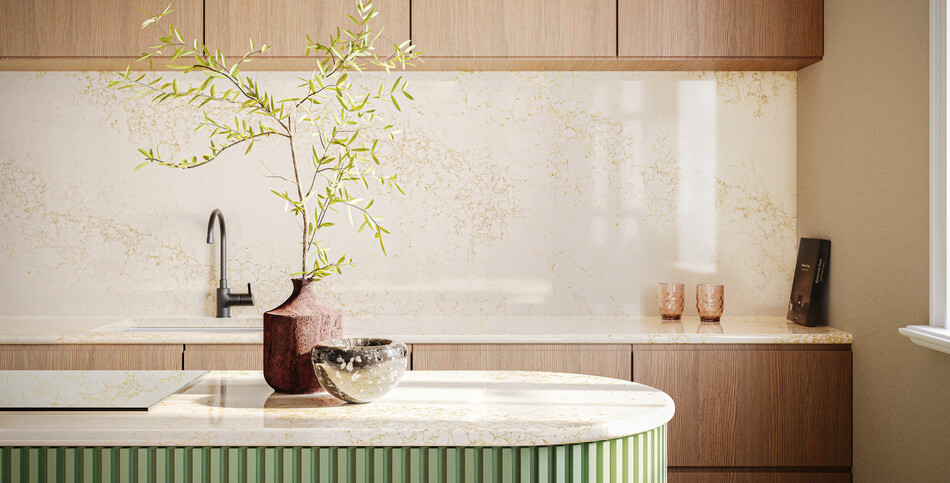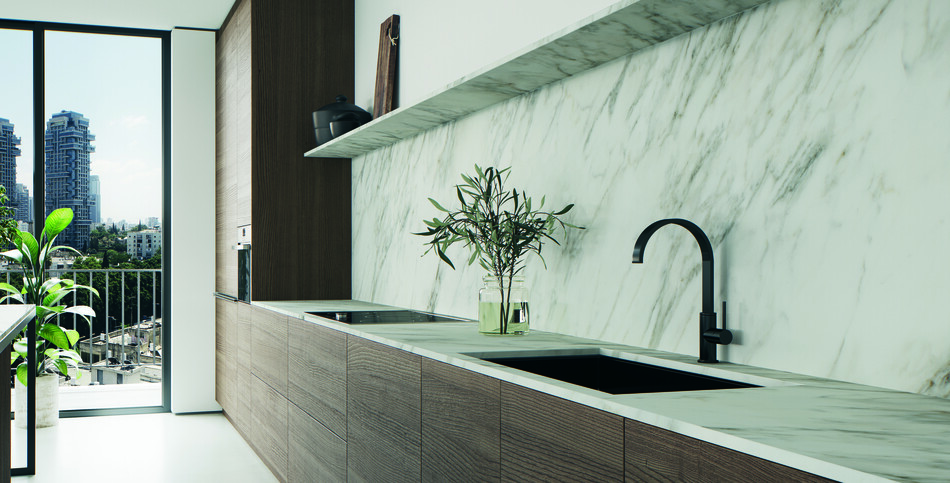What is the Standard Depth of Kitchen Countertops?
9 min read
Creating a gorgeous, high-functioning kitchen requires combining the perfect design, pattern, and correct dimensions. While the standard 25.5-inch countertop depth is a good starting point, understanding how depth relates to optimal ergonomics and appliance accommodation is essential for true functionality.
Standard-depth countertops help maximize workflow and provide the necessary coverage for 24-inch base cabinets. However, adjusting this dimension can provide strategic design benefits, including:
Ensuring your countertops meet your specific needs avoids issues that affect workflow, ruin the kitchen’s appeal, and could potentially devalue your home when it comes time to sell.
What is a kitchen countertop depth? Good question. The depth of a countertop is the measurement from the front edge, including any overhang, to the back edge that abuts the wall or backsplash. This distance is based on the depth of the base cabinets beneath it.
Here are the key standard kitchen countertop depth measurements to know:
| Component | Standard Measurement | Sizing Notes |
|---|---|---|
| Kitchen Countertop Depth | 25.5 inches | This is the most common residential depth. |
| Base Cabinet Depth | 24 inches | The depth of the cabinet box. |
| Countertop Overhang Depth | 1.5 inches | This small extension is for functionality and protection. |
The standard-depth countertop of 25.5 inches is designed to accommodate the 24-inch base cabinet while providing a functional 1.5-inch overhang. However, this measurement can sometimes change based on appliance depths, room size, and backsplash details. As a result, if you’re looking to replace your countertops, don’t automatically assume they’re the average size; always take careful measurements before you start shopping. While many general contractors or installers will assist with this crucial step, you can also follow the instructions found in “How to Measure Countertops for Replacement.”

Island countertop depth is more flexible than perimeter counters. While the standard kitchen countertop depth is 25.5 inches, kitchen island depths are often greater to allow for extra workspace, seating, and appliances.
Most kitchen island countertops range from 27 to 28 inches deep to provide extra prep space. If an island includes a breakfast bar or seating area, the countertop will need to be at least 30 inches deep to provide adequate knee room and safety.
Ultimately, the depth of an island countertop depends on the available space. Some kitchens can accommodate a very large island, while others may require a more modest size.

The typical countertop depth of 25.5 inches didn’t happen by accident. Rather, this measurement is an optimal standard that balances ergonomics, appliance accommodation, and construction efficiency to maximize the functionality of a kitchen workspace. No more, no less.
Here are the specific influences that make 25.5 inches the industry standard:
The base cabinet’s depth is the fundamental starting point. Standard base cabinets are 24 inches deep (measured from front to back).
The 25.5-inch depth is designed to match most people’s comfortable forward reach, reducing strain during daily kitchen tasks such as meal prep and cleaning.
The final measurement must account for the size and practicality of all kitchen tools and appliances.
While the typical 25.5-inch countertop depth works for most kitchens, there are situations where adjustments are required, including:
Going custom with your countertop depth lets you create a kitchen that truly fits your space, but expect a bump in price for those bespoke dimensions. Also worth keeping in mind: What’s perfect for you may not appeal to potential future buyers, so it’s smart to team up with a savvy designer who can balance your ideal countertop depth with optimal ergonomics and long-term resale appeal.

When planning your new countertop installation, you need a material that is both durable and versatile. Caesarstone quartz, porcelain, and advanced fusion surfaces are all excellent choices for meeting your custom dimensional needs.

There is no one-size-fits-all approach, but the benchmark for functionality and aesthetics is the average depth of kitchen countertops: 25.5 inches. This dimension ensures you get the maximum functionality from your base cabinets and a comfortable work surface.
When customizing this dimension, Caesarstone surfaces are versatile and durable options to meet your unique installation requirements.
Order a sample to see how our materials can perfectly fit your custom kitchen dimensions.
It is designed to perfectly accommodate the standard 24-inch depth of base cabinets, leaving a 1.5-inch overhang for practical use, to protect the cabinet doors/drawers, and to make it easier to open them.
If you plan to have seating, your island countertop should be at least 30 inches deep to allow for a comfortable overhang (approximately 15 inches of knee clearance) for diners.
Yes, you can. While 25.5 inches is the standard, many homeowners opt for 27- or 28-inch-deep counters to allow room for larger appliances or to gain extra workspace. Be aware that deeper counters can make the back of the surface harder to reach.
For a standard kitchen, the depth is governed by the cabinet size, making the practical minimum close to 24 inches (61 cm). This is the functional minimum for a kitchen because standard base cabinets are 24 inches deep. The countertop is usually cut to be 24.5 inches or 25 inches to allow for a slight front overhang and to cover any unevenness in the wall.
{{ subtitle }}
{{ i.desc }}
{{ subtitle }}
{{ subtitle }}
